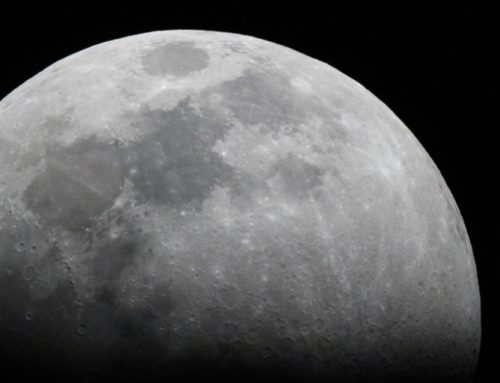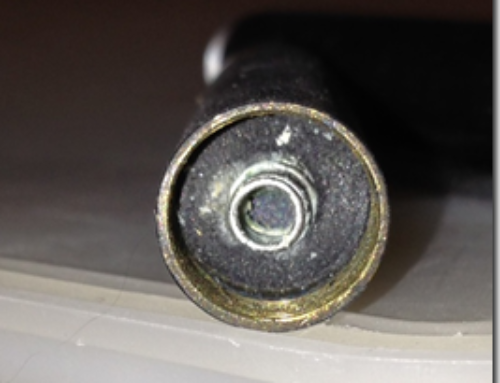I’ve had a recurring problem with my Celestron SCT C6 telescope since I received it in Feb, 2008. Every now and then, especially when I am slewing the scope, and more often in cold weather, the scope stops working and the hand controller resets to the power up state.
This means I have to re-align the scope to its initial position and re-initialize the hand controller. This problem even happened while just tracking in RA (right ascension). There have been times when this happened so often I could not get any observing in.
I found two root causes to this problem. It’s a combination of a poor fitting power plug into the telescope and an undersized power supply.
When the motion of the telescope jostled the cold and stiff power cable, it would cause an intermittent to the power feed and the hand controller would reset. After this loose plug problem was fixed, I found that under some slew conditions, the hand controller would still reset.
By using a power brick that could supply more current, this problem was completely eliminated.
Here is the complete story…
Initially, I thought this was a problem with the hand controller. The display would freeze out when it got below about 20 degrees F, and I thought maybe not only the display, but also the electronics might be having a problem with the cold. Even after building a heater for the controller, the problem continued.
As a technique to efficiently debug a problem, after a product as has been built, there are two critical ingredients.
- Make the problem reproducible
- Find the root cause
On a cold morning, I set up the telescope and was able to find a process of slewing the scope with a fast motion that enabled me to get the problem to occur over and over again. This was the first step.
What could be the root cause? Here is where brainstorming comes up. You need to find all the possible explanations- how could you create this problem if you wanted to design this behavior?
I noticed that the problem was the hand controller went into its initial power up state. It was as though the power was momentarily turned off. That’s when I started paying attention to the power brick supplying power to the scope.
The power cable from the power brick to the telescope gets stiff and brittle when cold. I noticed that as the telescope turned, if any of its cables touched the power cable, it would move it ever so slightly. Being stiff, the slight motion was transmitted to the plug and it would in turn move in the socket breaking contact for a short time. I could reproduce this power up problem by just touching the power cable.
I took the telescope apart and brought it into my lab and monitored the voltage to the scope as I gently rocked the power plug. Here is the circuit board with the power connector on it in close up:
I clipped a few leads on the back side of the board to monitor the DC voltage onto the circuit board. Here is the arrangement of the clips. I also added a 2:1 voltage divider to bring the 12 v dc level down to 6 v to make it easier to read with my scope.
The power supply was plugged into the wall and I monitored the voltage on the circuit board as I jiggled the power connector slightly. Sure enough, I saw a number of very short voltage transients where the voltage literally turned off.
Here is an example of one scope trace showing the transient.
This was definitely the source of the hand controller initializing. The reason it was more common in the cold was due to the power cable getting stiff and more sensitive to any motion.
The quick fix was to replace the power plug. While this was a standard plug, with standard specs, due to sometimes poor manufacturing quality, some plugs come out slightly too small in diameter. I suspect this is to prevent the other problem of a plug not fitting into a socket.
After I wired in a new plug, which felt like a tighter fit, I could not re-create the glitch no matter how much I moved the cable and connector around. Here is an example of what the on-board voltage is supposed to look like:
I put the motor assembly back together and tested it out in the cold. While it eliminated the problem of touching the power cable causing the scope to re-set, it did not completely eliminate the problem.
I was still able to cause the re-set by slewing the scope in some positions. I noticed that if the scope was unbalanced, it would initialize after slewing just a little. Knowing that this re-set problem looked just like a power off problem, I thought it likely the root cause of the problem was the scope motor drawing too much current and the power supply voltage dropping too low, causing the electronics to reset.
Celestron supplies a long power cable to the scope with a cigarette lighter plug on the end. They assume a user would power the scope either from their car, or from an external 12 v car battery capable of starting a car. It could deliver 100 Amps if the scope needed it.
For those of us who would use AC power to drive the scope, Celestron provides an AC to 12 v cigarette lighter plug adaptor similar to this one:
The one I had was rated at 180 mA. I did not test its voltage sensitivity to current load, but grabbed another power brick that output 12 v, but was rated at 500 mA.
I powered the scope with this brick and had zero problems with the hand controller. In fact, I was able to slew the scope even when it was grossly unbalanced. The scope is now very robust and does not reset under any conditions.
I also made sure the new power plug has a snug fit to the power socket and I cannot get a power reset no matter how much motion of the plug. I think this fixed the problem.
I suspect that the problem I have had from the very beginning with this scope was a poorly fitting power plug and an undersized DC supply. These problems are now eliminated and my scope goes anywhere I want, all night long.










